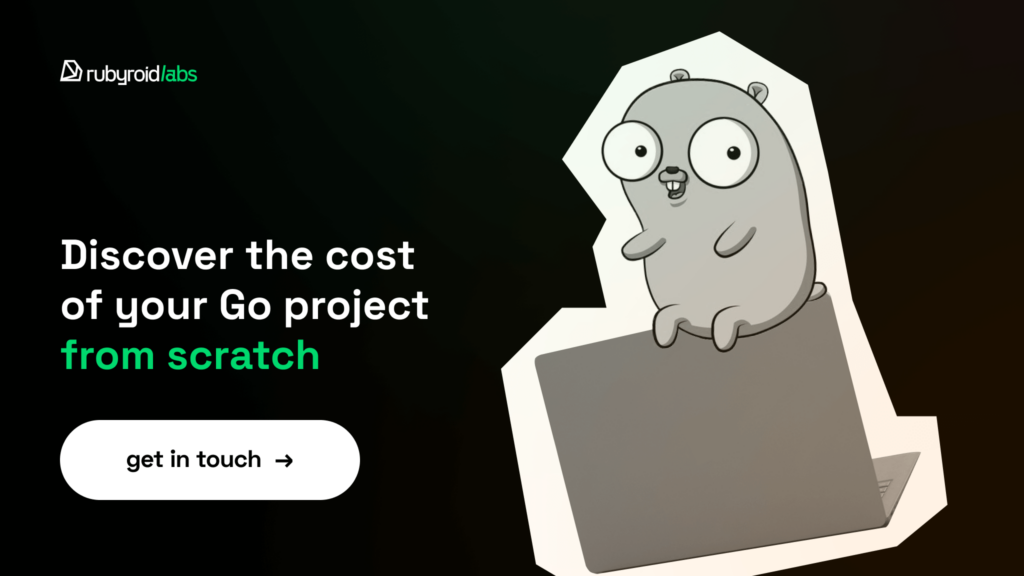Depending on the tech stack you choose for your project, the development process can be full of bumps or as smooth as silk. The coding tools should ideally fit the goals of the project and be comfortable enough to quickly write code at the same time.
In this context, the Go programming language is a rising star. Golang has skyrocketed in popularity in the past couple of years. And the reason is right in front of us: there are more company owners that require strong and scalable software, applications, and cloud solutions able to process enormous quantities of users and large volumes of data.
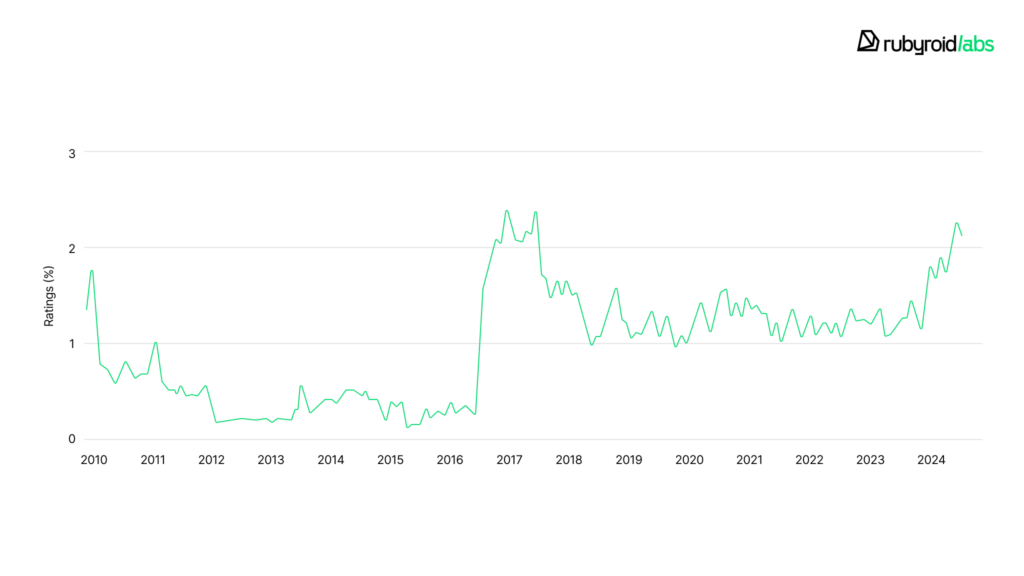
So, why Golang, and does it fit developing any type of software and web applications?
Let’s explore everything about this programming tool together: what characteristics make Golang in demand, its benefits and drawbacks, and the types of software Go fits best.
Continue reading, or get in touch with us right away to consult our team and discuss your specific Go web development needs.
Contents
- What is Go, and Why is It Popular?
- Key Features of Golang
- What is Go programming language used for? Popular Go Use Cases and Applications
- Benefits and Limitations of Go
- What’s the future of Golang?
- Conclusion
What is Go, and Why is It Popular?
What is Golang? The language, also known as Go, is an open-source coding tool primarily used for server-side and system development.
Golang was created at Google in 2007 with the purpose of developing an efficient and productive language that would make programming easier and safer than existing languages.
At that time, building multithreaded applications was a real headache.
Developers had to manage threads manually and bore a huge responsibility for doing so. Writing correct multithreaded code took a lot of time and was error-risky, as it required a deep understanding of concurrency concepts.
Here is what our VP of Engineering, Pavel, says about the appearance of Golang:
“All other existing languages such as C, C++, PHP, Python, Ruby, Java, and more were created during times when processors were single-core, making it very difficult to implement “true” parallelism (where code literally executes simultaneously). In fact, it was hard to realize parallel computing in these languages. Go, on the other hand, was built from the beginning with true, simple, and safe parallelism in mind. This is how the goroutines came to be. They are Go’s most powerful feature.”
The debut of Go tackled the challenges by bringing in goroutines and channels.
These skyrocketing features let developers code faster, safer, and juggle multiple tasks at once.
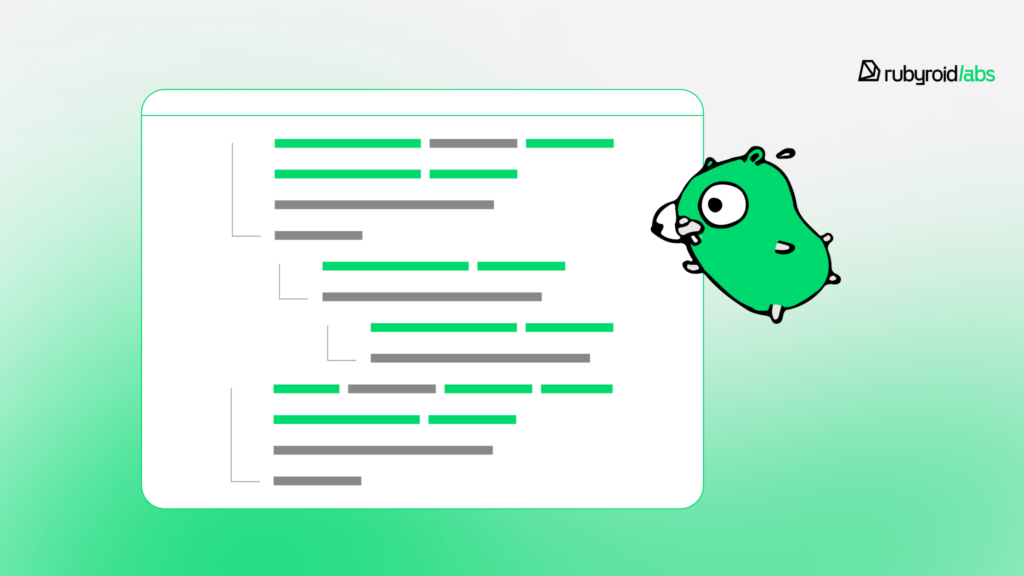
Why is Go in demand?
Over time, Go has entered multiple areas of software development and gained adoption across multiple sectors. This growing popularity is connected to the following factors:
- The choice of developers. More programmers fall for Golang for its clean, straightforward syntax that’s easy for learners to read and understand. The language adopts and adapts premier aspects of multiple programming paradigms. For example, it took the efficiency of C/C++, the parallelism handling capabilities of Java, and the readability of Python and Perl.
- Strong native instruments. Go’s built-in tools, such as efficient memory management, garbage collection, and concurrency, make it possible to build stable and performing applications, which guarantees their smooth and uninterrupted work.
- The rise of new tech trends. The current advances in technology have provoked new interest among businesses in cloud-based apps, microservice architecture for app development, and higher adoption of Internet of Things (IoT) technologies.
Go is strong and performant, and it provides a comprehensive toolkit for writing software for any industry. Let’s see in detail what it’s loved for.
Key Features of Golang
Being much younger compared to its ‘brothers’ such as C (1972), C++ (1979), Python (1991), and JavaScript (1995), Go’s design tackles many current problems and requirements through its features.
Let’s explore the most essential of them.
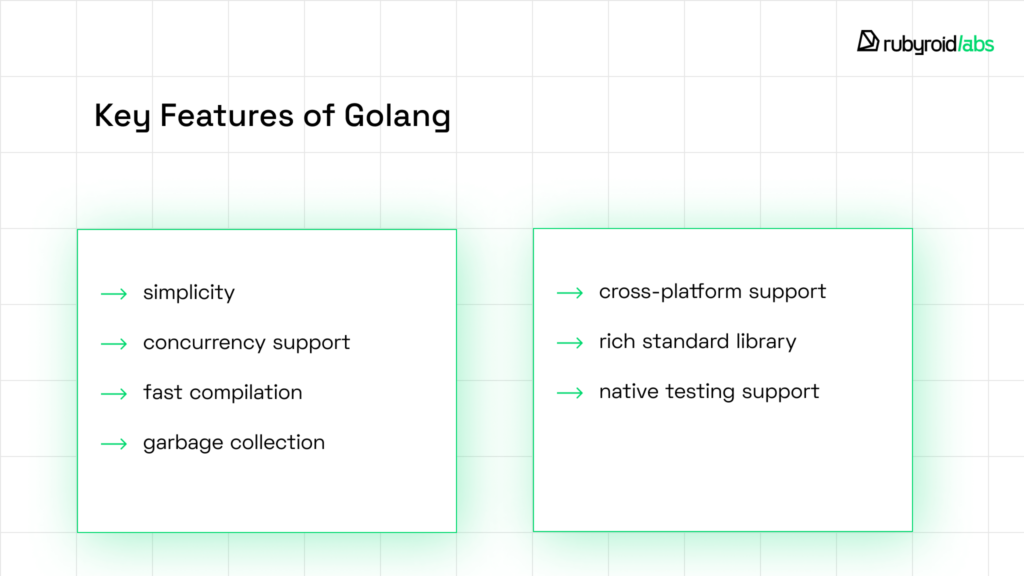
Simplicity
Golang is more intuitive to learn and code. Its syntax is simple and neatly organized, with few special characters or complicated structures. This improves code readability and understanding at first glance.
Concurrency support
Go’s main benefit is its ability to handle concurrent operations efficiently.
In a nutshell, goroutines are useful, lightweight functions that execute autonomously and are controlled by their boss—the Go runtime. This boss rules the goroutines, memory management, and garbage collection. As for channels, they are like nice walkie-talkies, letting goroutines contact each other.
Meanwhile, usual threads are limited to the operating system as their micromanager.
Thus, when developers need to work on multiple tasks simultaneously that are not necessarily dependent on each other, they do so without writing purely sequential code.
Through goroutines and channels, programmers can effectively create concurrent systems, such as managing multiple client requests on a web server or processing data in parallel.
Unlike in other languages, when implementing concurrency, Go developers don’t need to deal with routine tasks and the maintenance of this concurrency. Golang includes this capability by default, and developers don’t need to make extra moves or get worried about memory management, threads, and so on. All of this is handled by the language runtime.
Fast compilation
Compilation is a pain point for web development platforms such as Java and.NET, which are frequently used in enterprise applications: insurance, banking, healthcare, and logistics. In these sectors, performance is crucial. Go not only keeps pace in terms of performance but also in some areas even outperforms them, while avoiding all these common issues: slow compilation on large projects, challenges with concurrency support, and so on.
The Go development environment offers a huge benefit as it does not require a virtual machine. This enables the direct compilation of code into machine code, which greatly speeds up the development process.
The compiler creates a single executable file with few external dependencies, resulting in faster and more efficient code execution.
With the speedy compilation, developers may write and test code more rapidly, with results appearing practically instantly. This quick feedback loop shortens the total development period.
Cross-platform support
The Go compiler can generate executable files for several operating systems and architectures using the same source code. This process is known as cross-compilation. So, code written in Gо runs on various platforms, such as Linux, macOS, Windows.
Rich standard library
Golang includes a rich standard library, which reduces the need for third-party packages. The language has a number of standard built-in functions that boost the development process.
Native testing support
Go has its own testing framework as part of its standard library. The framework offers unit tests, benchmarks, and examples, making it simpler to conduct various types of tests. Developers can code and run tests without complicating things by using external tools or libraries.
The testing process becomes faster, which positively influences the fast pace of development cycles.
The same applies to the web server. It’s built-in, so there’s no need for NGINX, Apache, or similar external servers that are commonly used with other programming languages.
Garbage collection
In languages without garbage collection, programmers have to allocate and free memory by hand. The Go language has automatic garbage collection, which enables the runtime to handle memory allocation and deallocation without developer participation. Collecting garbage is already available in almost all the mainstream programming languages. However, combined with Golang’s top features like concurrency and fast compilation, it’s another great advantage.

What is Go programming language used for? Popular Go Use Cases and Applications
Go is agile enough to handle projects of any size, from small apps to large-scale distributed systems, across a broad range of industries. The language can be used in the backend. development of various projects; however, it has already shown its performance in certain types of apps:
Real-Time Application Development
Real-time applications are systems that take requests and return results swiftly with little to no delay. They’re like a 24/7 customer service hotline, where a person calls in and gets a prompt answer from a specialist without long wait times. The principle of real-time apps is identical.
Golang is great for developing real-time apps and a wide range of other applications alike.
Live Streaming
Examples: YouTube Live, Facebook Live, Twitch
These platforms offer real-time video streaming and viewer interaction.
Game development
Examples: Gowog, Riot Games (League of Legends)
In game dev, Go has found its place in certain areas, particularly in server-side operations for multiplayer online games.
Collaborative Tools
Examples: Google Docs, Miro
These tools allow multiple users to work on the same document or project online and display changes immediately.
Networking Development
Network development refers to creating software applications and systems that enable devices to interact successfully over a network.
Networking can be compared to a postal service infrastructure. Just as the postal service handles the transport of mail and packages between locations, network development creates systems to manage data transfers between devices.
Golang here is like a highly efficient postal worker who can sort, route, and deliver items promptly and safely. So, it is widely used in many networking applications, including:
Network Monitoring Tools
Examples: Prometheus, Grafana (has components written in Go)
These tools collect, analyze, and visualize network performance data in real-time.
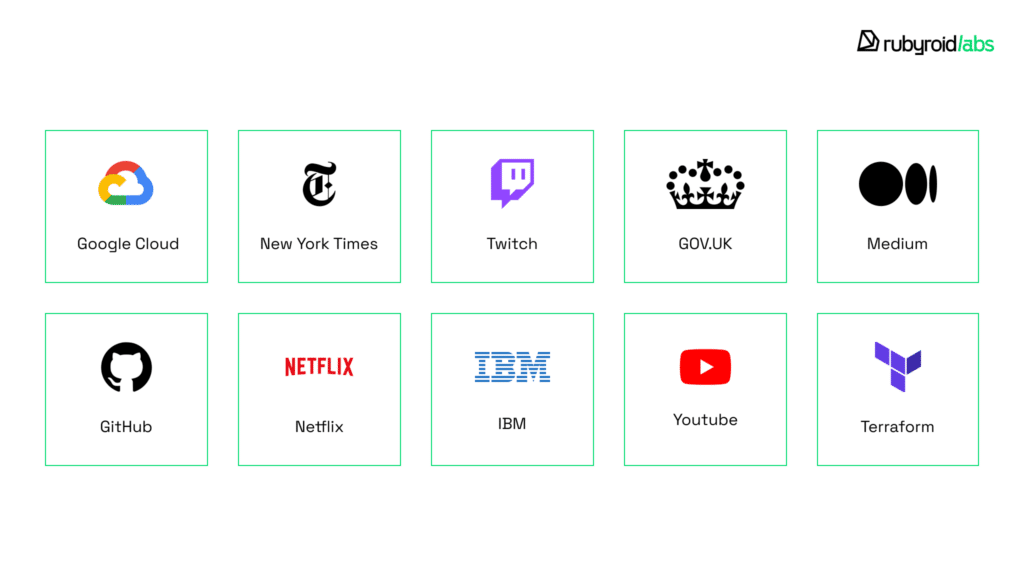
VPN Clients and Servers
Examples: Outline, WireGuard (has an implementation in Go)
The applications create secure, encrypted connections over public networks.
Cloud-based applications
A cloud-based app is comparable to a public library. Instead of storing books at home, you can take them from many library branches (remote servers). Such an app stores data, conducts computations, and provides internet-based services, just like libraries do with books, research assistance, and community services.
Golang here is comparable to an efficient librarian. It specializes in managing the library’s operations (cloud infrastructure), handling several visitor queries concurrently (concurrent processing), and efficiently obtaining and arranging books (data management).
Go is well-suited for building cloud-based applications and is utilized in a variety of the following examples of cloud-oriented solutions:
Infrastructure-as-a-Service (IaaS)
Examples: DigitalOcean, Droplet API (uses Golang)
The platforms offer virtual computing resources via the internet.
Cloud Storage Solutions
Examples: Minio (written in Golang), Sync (by Resilio, uses Golang)
These apps offer large-scale data storage that users can access online.
Microservices
Microservices are an architectural approach in which an application is organized like a collection of smaller, independent services.
One of the main advantages of microservices is their reliability. The entire application is split into independent pieces or services, which can be duplicated. In short, you have a team of primary players, but there’s also a bench of reserves ready to jump in at any moment. This is why such services operate almost without fail and can handle heavy loads. Google is a prime example of this approach.
Golang can also be utilized in a variety of microservice-based systems, including:
E-commerce Platforms
Examples: Zalando, Shopify
Microservices are used here to handle different functions, like inventory management, payment processing, and user authentication.
Financial Services
Examples: PayPal, Square
These companies employ microservices for tasks like transaction processing, fraud detection, and account management.
Benefits and Limitations of Go
Go’s exceptional functionalities make it stand out among other programming languages for modern software development. Speed, efficient memory management, and built-in concurrency support are serious pluses if you want to build an efficient and scalable program.
Let’s figure out how your project can benefit from Golang web development.
Developer-friendly
Go is easy to learn and develop with, which helps accelerate building programs.
Faster development
Fast compilation of the code lets developers see the result quickly, correct the bugs, and release more stable apps in a shorter time.
Concurrent programming
Go’s goroutines and channels allow for the concurrent run of several tasks, which improves system utilization of resources.
Cross-platform benefits
Code written on one platform is readily maintained on others. You don’t need to to maintain separate codebases for various operating systems and platforms.
Versatility
Go is useful for a variety of applications, including web development, data analysis, streaming services, media platforms, and cloud computing.
Apart from all its features and benefits, the Go programming language also has limitations. Let’s concentrate on them, as when considering Golang for your project, you should analyze hidden pitfalls that can significantly impact your project.

The limitations of Go that we enumerate below are shaped by the experiential insights of our engineering department and may differ from those published on the internet.
Lacks complexity for building large applications
The difficulty of writing large applications is a significant drawback. Go is great for building small services and microservices, but it’s not comfortable for large monoliths with a substantial amount of code.
Pavel, the VP of Engineering, shares his experience:
“If we compare Go vs. Ruby, the latter is more readable. Ruby’s metaprogramming capabilities and DSLs help solve problems very quickly with minimal code. Go, on the other hand, is quite different. It’s not as concise, requiring more specificity, more details, and more attention. In Ruby, you can metaphorically launch a rocket into space with one line of code, while in Go, creating even a simple array requires more effort.”
Different from the rest
Go is not the object-oriented programming (OOP) that many developers work with.
Golang is a multi-paradigm language that supports some functional programming techniques:
It handles first-class functions, higher-order functions, and closures. However, it lacks key functional properties like immutability, pattern matching, and lazy evaluation.
At its heart, Go adheres to an imperative programming model and incorporates some object-oriented and functional features. It allows for functional techniques without emphasizing a purely functional style.
The paradigms of Golang can be quite confusing for programmers with limited experience in different programming styles.
Requires a technical background
While Go offers clarity and a gentle learning curve, it’s typically used for projects that require solid technical knowledge. Developers lacking this background are likely to make critical mistakes right from the start of coding. In contrast, with Ruby on Rails, everything comes out of the box, and even someone with minimal programming knowledge can figure it out and build their own online store.
Limited GUI support
Go lacks robust, officially supported Graphical User Interface (GUI) libraries. This makes it less suitable for developing desktop applications compared to languages with mature GUI frameworks.
Choosing an appropriate tool for a project can be challenging, as it requires analyzing every detail with a client. Despite Go’s unique attributes, we always consider project-specific requirements when choosing a tech stack. Different goals may require different languages. That’s why we thoroughly discuss project details with clients. Each task has its ideal language, and we aim to select the best tool for the job, whether it’s Go or another language that better suits the project’s needs.
What’s the future of Golang?
The future of Go can be forecast based on its current market position, and it looks really optimistic. Our developers, well-versed in Go, have shared their insights for the language’s future:
- Expanding the developer base: The simplicity with which Go can be learned ensures a growing pool of qualified developers.
- Versatility: Go excels at both high-level and low-level programming, making it appropriate for a variety of industries, including banking.
- Microservices: As microservice architecture becomes more popular, Go is being used for at least certain components on many platforms.
- Performance: Go-based web apps outperform those constructed using other languages and technologies.
These characteristics show a bright future for Go in software development. Businesses continue to seek efficiency, scalability, and fast development, and Go’s capabilities perfectly meet such needs.
Moreover, as Go demonstrates its simplicity and maintainability, it is more appealing for long-term projects, particularly for project owners dealing with high-concurrency scenarios.
There is a significant event that might impact Go’s future as a project.
As announced, on September 1, 2024, the tech lead of the Go project, Russ Cox, is stepping down from his position after 12 years in the role. This might seem like a significant change for such a huge undertaking. However, the new tech leader, Austin Clements, is a reliable specialist with a wealth of experience. In fact, the community’s reaction to the change appears to be largely positive. Taking all this into consideration, we can say that the transition seems well-planned, with experienced team members taking on leadership roles.
Go will continue expanding, growing its third-party ecosystem, and further providing developers with powerful tools.
The demand for solid and fast-deployable software solutions will continue to grow, so we can expect Go to have an impact on the future of software development in all industries.
Conclusion
Whether you want an application built from scratch or microservices added to the existing app with a robust ‘engine’ able to process continuous data flow, Golang is definitely your choice.
From cross-platform development and data analysis applications to media or streaming platforms, Golang has established itself as a top programming tool for various digital solutions, offering concurrent and clean code.
Developers choose it for efficiency and clarity, while project owners are satisfied with the fast development and reliability.
As a leading Golang development company, we carefully consider every requirement our clients present to us. We help expand these ideas into the best user-oriented solutions that stand out among others. If you are searching for a development team for your project, our programmers are ready to assist you.
Over 40+ reviews and 5-star ratings on Clutch.co have confirmed our reputation as an approachable, problem-solving company with a highly communicative team.
Share your idea with us now, and we’ll promptly prepare an estimate. We can assemble a Golang development team within 3–4 weeks to kick off building your product.
